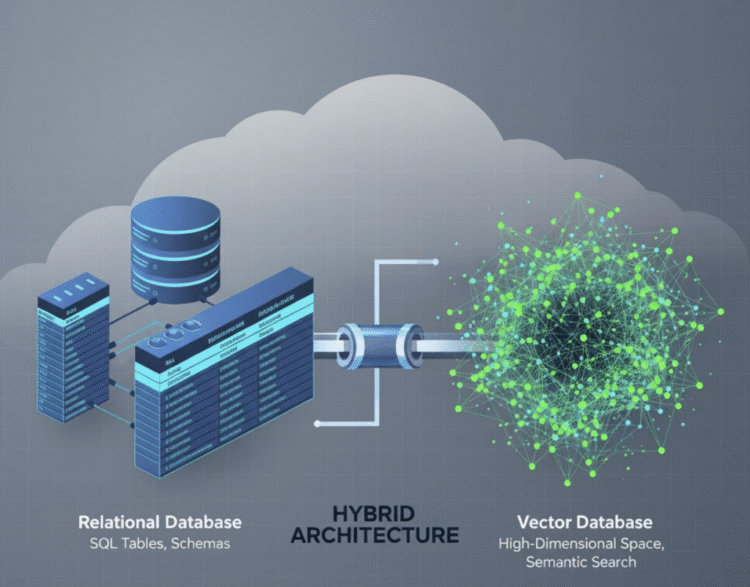PostgreSQL, MySQL, and Oracle have powered enterprise systems for decades; optimized for clearly defined schemas, transactional integrity, and predictable performance. They excel at answering what you asked, not what you meant.
Here is the problem: AI changes everything.
Modern AI systems don’t just look for exact matches; they look for meaning. They need to understand similarity, context, and relationships buried in text, images, and signals. A relational database can tell you that two records share an ID, but it can’t tell you that two sentences mean the same thing.
This is why vector databases exist. Instead of matching exact keys, they measure semantic closeness; how “near in meaning” one piece of data is to another. Using embeddings, they transform data into high-dimensional numerical space where proximity represents relevance. This unlocks capabilities like semantic search, personalized recommendations, and Retrieval-Augmented Generation (RAG) that traditional systems were never designed for.
In this article, we’ll explore how vector databases differ from traditional relational systems, from architecture to performance. You will learn what to consider when building a scalable, AI-ready data infrastructure that connects accuracy with understanding.
You Might Like: How Can Cloud Computing Essentials Unlock Benefits for Businesses?
Traditional Databases: Strengths and Limitations
Relational databases such as PostgreSQL, MySQL, Oracle, and Amazon Aurora are optimized for structured, transactional workloads. They organize data in tables with defined schemas and rely on SQL for querying.
Key strengths include:
- Predictable performance – ACID-compliance ensures consistency and integrity.
- Efficient indexing – B-tree and hash indexes enable fast lookups and joins.
- Transactional safety – Ideal for financial systems, ERP, and e-commerce workloads.
But these strengths come with limitations when handling AI-driven data:
- Schema rigidity – Predefined structures make it difficult to accommodate unstructured inputs like text, images, or embeddings.
- No similarity search – SQL queries use equality and range filters, not cosine or Euclidean distances.
- Scalability trade-offs – Scaling vertically (bigger hardware) hits limits when processing millions of feature vectors.
Relational databases reach their limitations when data shifts from structured tables to a high-dimensional embedding space.
Vector Databases: Designed for AI-Driven Workloads
Vector databases are designed to manage high-dimensional embeddings. These embeddings convert data points such as words, images, audio, and documents into numerical vectors that capture meaning and similarity.
Unlike SQL systems, vector databases use Approximate Nearest Neighbor (ANN) algorithms like HNSW, IVF, or PQ to store and query these embeddings. Instead of seeking exact matches, they evaluate the proximity between vectors to identify the “most similar” entries. Leading implementations include:
- pgvector – Adds vector search to PostgreSQL.
- Milvus – A popular open-source vector database for large-scale similarity search.
- Pinecone – A managed vector database for RAG and personalization workloads.
- AWS OpenSearch Service – Supports hybrid search with both vector and keyword indexes.
- FAISS – A library from Meta optimized for vector similarity computation.

Vector databases are purpose-built for use cases like:
- Semantic search: Retrieve documents with related meaning, not identical text.
- Personalization: Match users to products or content based on behavior embeddings.
- Recommendation systems: Find items most similar to what users like.
- Multimodal search: Query across text, image, and video embeddings together.
This architecture unlocks performance that SQL can’t achieve when handling unstructured, meaning-rich data.
Traditional Databases vs Vector Databases: Architectural Comparison
Traditional and vector databases differ in both how and what they store:
| Feature | Traditional Databases | Vector Databases |
| Data Type | Structured, tabular (rows, columns) | Unstructured (embeddings, feature vectors) |
| Query Type | Equality, range, joins | Similarity, distance metrics |
| Indexing | B-trees, hash maps | HNSW, IVF, PQ |
| Scale | Vertical (scale-up) | Horizontal (scale-out) |
| Latency | Millisecond for transactions | Sub-second for ANN queries |
| Best Use | Transactions, reporting | AI search, recommendations, RAG |
Vector databases aren’t designed to replace traditional database capabilities, they complement them. Traditional systems still handle transactions and structured data with precision. Vector databases take on a different class of problem: semantic workloads where the goal is to find meaning, not just matching keys.
Read More: Optimizing Cloud Computing Performance and Scalability.
Enterprise Use Cases
Many organizations are now deploying vector databases on cloud platforms for better scalability and integration with AI models.
Here are some key enterprise use cases where vector databases truly shine:
Retrieval-Augmented Generation (RAG)
Vector databases store document embeddings for LLMs. When a user prompts the system, it retrieves semantically relevant documents and passes them to the model. This approach delivers accurate, context-aware responses without retraining or fine-tuning your foundation model.
Personalization and Recommendations
User behavior, product descriptions, and interactions are transformed into embeddings. Similarity search helps recommend products or content that align with prior user activity, far beyond keyword matching.
Fraud Detection
Anomalies are prominent in vector space. By embedding transaction patterns, vector databases can detect deviations indicating fraudulent behavior more quickly than rule-based systems.
Multimodal Search
For industries like retail or media, vector databases power searches across text, image, and video simultaneously. For example, querying “red running shoes” retrieves visually and semantically similar products.
These applications rely on efficient pipelines to transform raw data into embeddings and feed them into queryable vector spaces.
Hybrid Data Architecture: The Best of Both Worlds
Most enterprises don’t replace their relational databases, and they shouldn’t. Instead, they’re integrating vector capabilities into existing systems.
- PostgreSQL with pgvector allows developers to add vector fields to relational tables, combining structured data with similarity search.
- AWS OpenSearch enables hybrid queries that mix keyword relevance with vector similarity.
- Milvus on AWS Elastic Kubernetes Service (EKS) integrates into broader data lakes for scalable AI workloads.
In hybrid architectures, structured metadata (e.g., user IDs, categories) remains in traditional databases, while embeddings live in vector stores. This separation lets teams run both transactional and AI-driven queries in parallel without duplicating infrastructure.
However, this introduces new challenges:
- Data synchronization – Keeping embeddings aligned with updated source data.
- Schema alignment – Maintaining consistent identifiers between systems.
- Governance and compliance: Controlling access to embeddings that may encode sensitive information.
When solved correctly, this hybrid model delivers both structure and semantic understanding, a foundation for enterprise-scale AI.
Implementation Considerations for Vector Databases
Implementing vector databases isn’t just about storing embeddings; it’s about engineering for speed, scale, and reliability. These design priorities help ensure production-grade performance in enterprise environments.
Integration and Query Handling
Efficient integration is key. For example, you can use middleware or APIs to combine SQL and vector queries. Frameworks like LangChain, pgvector extensions, and OpenSearch hybrid search simplify connecting structured metadata with vector-based similarity results. This unified approach keeps data access consistent across systems.
Index Performance Optimization
Vector search performance depends on the right indexing strategy. You can choose algorithms such as HNSW or IVF based on dataset size and query load.
- HNSW (Hierarchical Navigable Small World) excels in high-accuracy, low-latency search.
- IVF (Inverted File Index) works best for massive datasets where speed trumps precision.
Proper tuning of index parameters ensures queries stay responsive at scale.
Compliance and Data Security
Embeddings represent sensitive information and must be secured like any enterprise data asset. Apply IAM policies, encryption at rest and in transit, and audit logging through AWS CloudTrail. Evaluate what regulatory compliance requirements you need to satisfy (e.g. GDPR, HIPAA, SOC2, Sarbanes Oxley). There are granular controls for access and data protection that require careful consideration before you begin your design.
Scalability and Infrastructure
For large-scale workloads, deploy vector databases on containerized or managed platforms. For example, Milvus on Amazon EKS scales horizontally across clusters, efficiently distributing both storage and compute. This gives consistent performance as data and query volume grow.

When implemented with these principles, vector databases scale naturally with data size and model complexity, supporting enterprise AI workloads without sacrificing reliability.
Where Data Precision Meets Understanding
Vector databases don’t replace relational systems; they extend them. Relational databases power precision; vector databases power perception. Together, they form data architectures that can store facts and infer meaning.
Relational systems still enforce the integrity of every transaction. Vector systems add the intelligence to connect patterns across them. Pair SQL’s reliability with vector search’s semantics to build applications that think, adapt, and evolve as data grows in volume and complexity.
The future isn’t transactional or semantic. It’s both working in harmony to make data truly AI-ready.
Halo Radius helps engineering teams make that future real. We design scalable vector pipelines, optimize data architectures, and bring models like Amazon Nova into production-grade systems that are built right the first time.

















